The Interdependent Lives of Clown Fish and Anemones
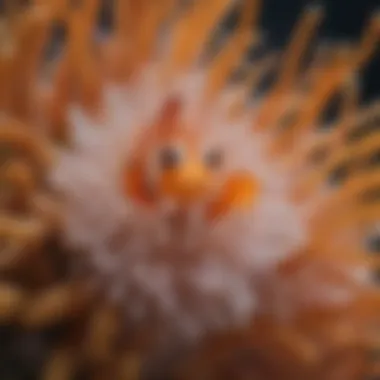
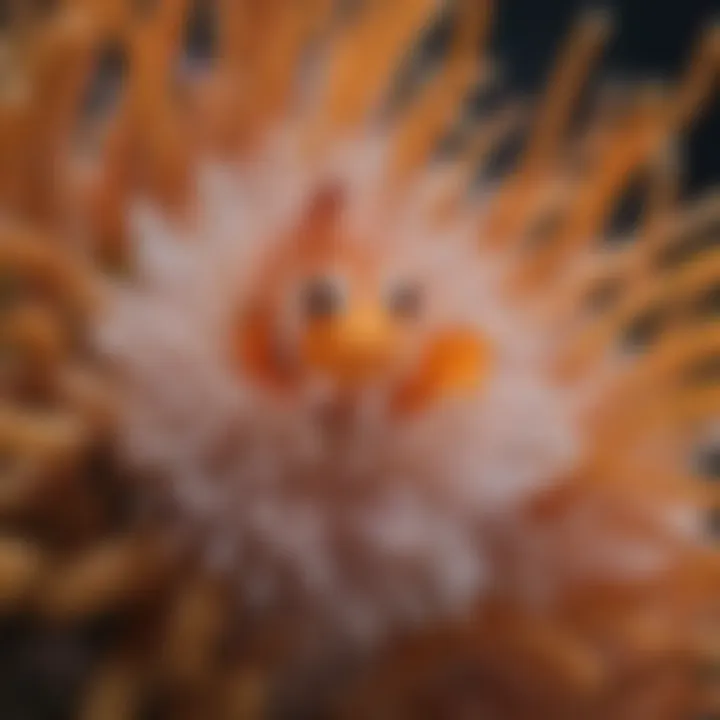
Intro
The relationship between clownfish and sea anemones is a unique example of symbiosis in marine ecosystems. Both species rely on each other for survival, creating a mutually beneficial partnership. The clownfish finds shelter among the stinging tentacles of the anemone, while the anemone benefits from the clownfish's presence. This article will examine the complexities of this relationship, exploring the biology, ecological significance, and conservation challenges of clownfish and anemones.
Recent Advances
Latest Discoveries
Recent studies have unveiled significant discoveries related to the symbiotic relationship between clownfish and anemones. Researchers have learned more about the clownfish's ability to tolerate the anemone's venom. This tolerance is largely due to a layer of mucus that protects clownfish from stings. This mucus layer contains proteins that reduce the anemone's nematocysts' ability to fire.
Furthermore, the behavioral patterns of clownfish have also been observed to contribute to their survival within anemones. It was noted that clownfish perform a unique dance-like behavior when approaching the anemone, allowing them to acclimate and gain acceptance. This subtle behavioral adaptation shows the remarkable evolution these creatures have undergone to thrive in such environments.
Technological Innovations
Innovative monitoring technologies are now being used to study these marine inhabitants. Underwater drones and remote-operated vehicles are allowing researchers to observe clownfish and anemones in their natural habitat without substantial disturbance. These tools provide valuable data regarding their interactions and environmental conditions affecting this symbiotic relationship.
Methodology
Research Design
The approach to studying clownfish and anemones typically involves both field studies and laboratory experiments. Field studies focus on observing the behaviors and interactions in natural settings, while laboratory experiments aim to isolate specific variables to understand the mechanisms behind their relationship more clearly.
Data Collection Techniques
Researchers utilize various techniques for data collection. Video monitoring is used to record the behaviors of clownfish as they interact with anemones. Biomolecular analysis of mucus samples helps determine the proteins responsible for venom tolerance. Surveys of anemone populations across different ecosystems provide insights into how environmental factors affect clownfish-anemone dynamics.
"Understanding the specific mechanisms of this relationship can lead to effective conservation strategies, ensuring both species' survival in a changing marine environment."
Through these research methodologies, important insights will continue to emerge regarding the interactions between clownfish and anemones.
Intro to Clown Fish and Anemones
Understanding the relationship between clown fish and sea anemones is essential for grasping marine ecosystem dynamics. This topic not only covers biological adaptations but also delineates how these two species coexist, providing mutual benefits that are critical for their survival. Such interactions highlight the complexity and importance of symbiotic relationships in nature.
The intrigue surrounding clown fish and anemones lies in their unique bond. Clown fish, commonly known for their vibrant colors, have evolved specialized adaptations that allow them to thrive within the stinging tentacles of sea anemones. This protective arrangement allows clown fish to evade predators while providing anemones with nutrients and increased food particles. The exploration of this topic reveals essential details about species interdependence, energy transfer in ecosystems, and the evolutionary process.
Overview of Clown Fish
Clown fish, belonging to the family Pomacentridae, are small, colorful fish that primarily inhabit the warm waters of the Pacific and Indian Oceans. They are often associated with the genus Amphiprion, which includes several species, such as the popular Amphiprion ocellaris, commonly known as the common clown fish.
These fish are notable for their orange coloration, accented with white bands. Clown fish are typically about four to five inches in length, although sizes can vary among species. Their social structure is hierarchical, often seen forming groups led by a dominant female and a group of smaller males.
The primary diet of clown fish consists of zooplankton, algae, and small invertebrates. Their resilience and adaptability have allowed them to thrive in a variety of habitats, albeit they primarily associate with sea anemones for not just safety but also nutritional needs.
Overview of Sea Anemones
Sea anemones, belonging to the phylum Cnidaria, are soft-bodied marine animals known for their captivating beauty and stinging tentacles. They are stationary creatures typically found in shallow waters of the ocean. The most common genera include Actinia and Heteractis, which often provide refuge for clown fish.
Anemones have a cylindrical body, resembling a flower and are often brightly colored. Their tentacles are lined with stinging cells called nematocysts, which serve both for defense and capturing prey. These tentacles can immobilize small fish and invertebrates, allowing anemones to feed efficiently.
Beyond their role as beautiful marine creatures, sea anemones also play a significant role in their environments by promoting biodiversity. They provide habitat structures for many marine species and contribute to the overall health of coral reef ecosystems.
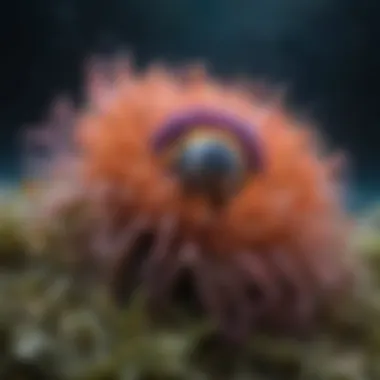
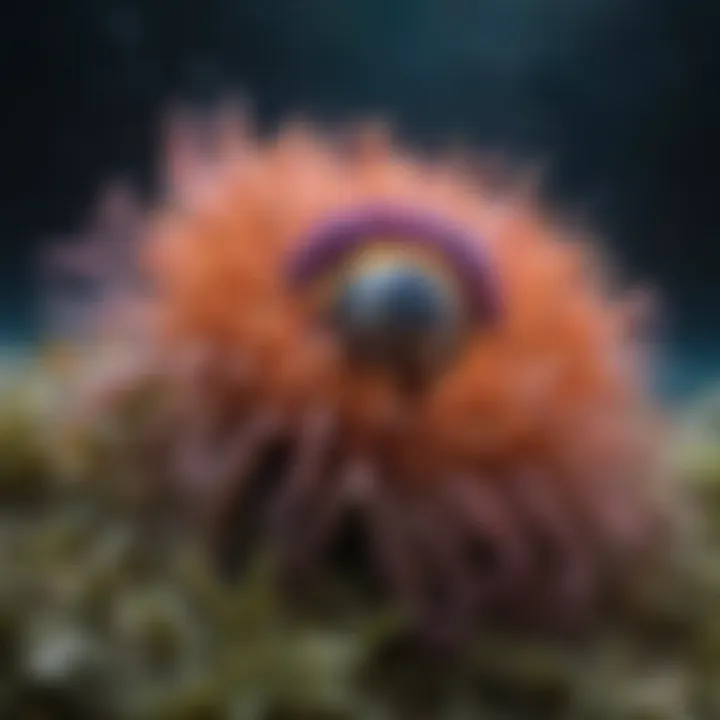
"The intricate interactions between clown fish and sea anemones represent a classic example of mutualism in the marine world."
In summary, studying clown fish and sea anemones not only enhances our comprehension of their behaviors and adaptations but further elucidates the broader ecological implications of their symbiotic relationship.
The Symbiotic Relationship Explained
The relationship between clown fish and sea anemones is an excellent example of symbiosis in action. Understanding this interaction is crucial for comprehending the dynamics of marine ecosystems. The clown fish provides a layer of protection for the anemone, while the anemone offers a safe habitat for the clown fish. Such interactions illustrate the nuances of biological relationships that define community structures in marine environments.
Defining Symbiosis
Symbiosis refers to any interaction between different biological species that live in close physical proximity. This relationship often results in benefits for at least one of the organisms involved. There are three main categories of symbiosis: mutualism, commensalism, and parasitism.
In the context of clown fish and anemones, mutualism is the dominant form of symbiosis, showcasing the mutual benefits that both organisms reap from their interaction. This type of relationship emphasizes collaboration and interdependence, which can be vital for survival in the complex marine habitat.
Types of Symbiotic Relationships
Mutualism
Mutualism is characterized by an exchange of benefits that contributes to the well-being of both species involved. In the case of clown fish and anemones, the clown fish not only receives protection from predators but also gains safety from the anemone's stinging tentacles. The anemone, in turn, benefits from the clown fish's presence, as it helps to keep the anemone clean and free from harmful parasites.
This type of relationship is popular for discussion because of its clear depiction of cooperation in nature. The distinct advantages it offers highlight the evolutionary adaptations that allow both species to thrive.
Advantages of mutualism in this relationship include enhanced survival rates for clown fish and a more stable environment for anemones, supporting overall reef health.
Commensalism
Commensalism involves a relationship where one organism benefits while the other is neither helped nor harmed. While not directly applicable to the clown fish-anemone relationship, it’s essential to mention as a contrasting example of symbiosis.
In similar marine scenarios, smaller fish might inhabit the shells of larger sea creatures without impacting them significantly. Such relationships underline the diversity of interactions that occur in marine ecosystems, even if they don’t provide the same mutual benefits.
Parasitism
Parasitism occurs when one organism benefits at the expense of another. This relationship is generally characterized by a negative impact on the host species. While clown fish and sea anemones mainly engage in mutualistic behavior, knowing about parasitic relationships in other fish species helps us understand the ecological context.
For instance, some fish may host parasites that can weaken them, impacting their ability to thrive. Such understanding can contribute to comprehensive research on marine biodiversity, addressing the overall health of aquatic environments.
"The balance of these relationships shapes the ecological and social fabric of marine life."
A detailed view on mutualism, commensalism, and parasitism offers a well-rounded perspective on the complexities found within aquatic ecosystems. Understanding these dynamics is crucial for making informed decisions regarding conservation and ecological studies.
Mutual Benefits of the Clown Fish-Anemone Interaction
The relationship between clown fish and sea anemones is far from trivial; it embodies a sophisticated network of mutual benefits that enhance survival for both organisms. Understanding these benefits is critical as it reveals the evolutionary significance of their interaction. This section outlines various advantages that clown fish and anemones derive from their association, emphasizing their interdependence in marine ecosystems.
Protection from Predators
One of the most significant benefits of the clown fish-anemone partnership is the protection each offers to the other. Clown fish are known for their striking colors and size, making them an easy target for predators. However, their presence near anemones provides them a unique sanctuary. The tentacles of sea anemones possess nematocysts, which are stinging cells that can deter many potential threats. In this way, clown fish gain a reliable defense against larger fish and other predators.
For anemones, clown fish provide a level of protection too. Certain fish, like butterfly fish, can nibble on anemones. The presence of clown fish reduces the risk of predation. This dynamic illustrates a clear mutual benefit: clown fish enjoy safety while anemones deter potential threats.
Nutritional Benefits
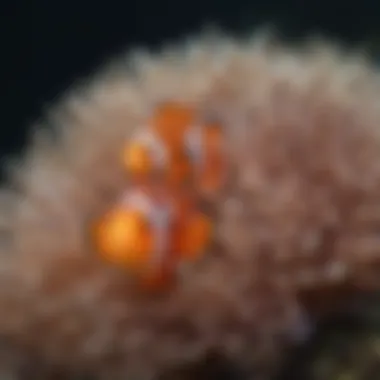
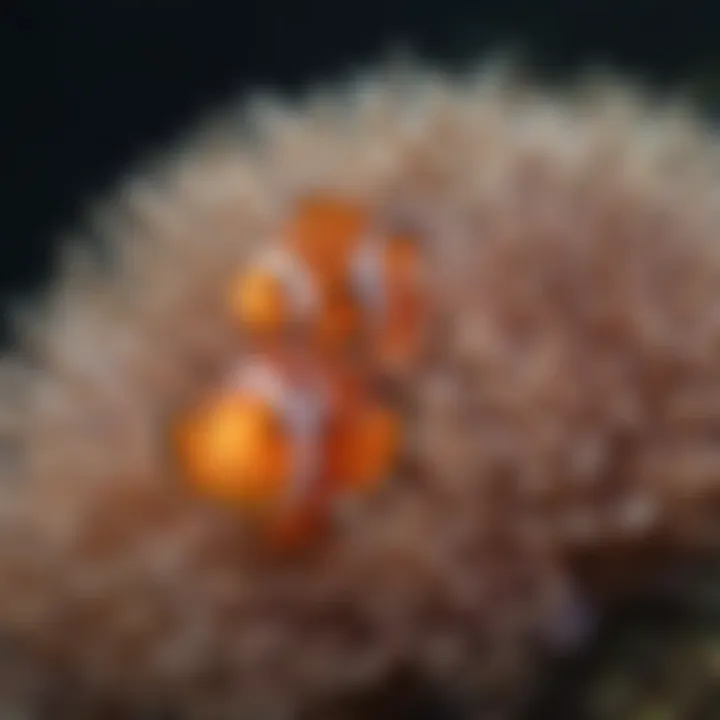
Nutritional exchanges also characterize this relationship. Clown fish benefit from the food particles that anemones capture in the water. The clown fish often feed on leftover prey or uneaten leftovers of its host. In return, clown fish contribute to anemones' nutrition as well. They produce waste, which serves as an organic nutrient source for the anemone.
Additionally, the movement of clown fish stimulates the water around the anemones, helping to circulate oxygen and nutrients. This two-way transfer of nutrients is crucial for sustaining both species. Thus, the relationship yields significant advantages for survival, underscoring the importance of their ecological roles.
Habitat Stability
The clown fish and sea anemone partnership fosters a stable habitat vital for their survival. Clown fish create a consistent environment for their anemone hosts. Their behavior of cleaning and maintaining the anemone's health enriches the habitat, which enhances growth and reproductive success. Healthy anemones support the clown fish's occupation and create a buffer against environmental factors.
Both species thrive in coral reef ecosystems and contribute to their overall health and stability. By providing shelter and support, clown fish enable anemones to flourish in their habitat. In return, the anemones provide clown fish a safe place to reproduce and mature.
As a result, the mutual benefits of this relationship go beyond individual survival. They signify an intricate ecological balance critical for maintaining the health of coral reefs, showcasing the importance of these two species in marine biodiversity.
Biological Mechanisms of Interaction
Understanding the biological mechanisms behind the interaction between clown fish and sea anemones is crucial for grasping the complex dynamics of their relationship. These mechanisms are not just structural; they involve biochemical adaptations and behavioral responses that allow both species to coexist in a fragile marine environment.
The clown fish has developed specific features and behaviors that enable it to thrive among the stinging tentacles of anemones. At the same time, this interaction serves broader ecological purposes. For instance, the behavioral and physiological traits that clown fish exhibit help maintain the ecological balance within coral reef ecosystems.
Mucus Layer Adaptation
The mucus layer of clown fish plays a pivotal role in their interaction with anemones. This mucus may appear simple, but it serves significant functions. First, it provides a protective barrier against the anemone's stinging cells, called cnidocytes. Each species of clown fish produces mucus with a unique composition, which helps to create a tolerance to the anemones’ venom. This mechanism ensures survival where other species fail due to the potent toxicity of the anemones.
Moreover, the mucus layer can facilitate the clown fish's ability to maneuver among the tentacles without eliciting a defensive response from the anemone. It appears that the anemones can recognize specific mucus proteins that signal a non-threatening presence. This allows clown fish to find shelter, helping reduce predation risk.
Behavioral Adaptations
In addition to physical adaptations, clown fish exhibit distinct behavioral traits that support their interaction with sea anemones. These behaviors include a gradual acclimatization process when a clown fish first encounters an anemone. The fish will typically approach the tentacles cautiously, engaging in a series of movements that help to induce a defensive, yet non-aggressive response from the anemone.
Once acclimated, clown fish display ongoing behaviors that reinforce their protective relationship. They often perform "dance-like" motions, which may help to reinforce their status as a symbiont rather than a threat. Such behaviors reassure the anemone, allowing it to lower its defenses and provide shelter.
Ecological Significance of the Relationship
Understanding the ecological significance of the relationship between clown fish and sea anemones is crucial for grasping their roles in marine ecosystems. These two species exemplify a harmonious association that extends beyond mere survival; it influences broader ecological patterns and interactions. Their symbiotic relationship affects not only their populations but also impacts the health and stability of coral reef ecosystems.
Role in Coral Reef Ecosystems
Clown fish and sea anemones play pivotal roles in maintaining the balance within coral reef ecosystems. The presence of clown fish can enhance the health of sea anemones. By clearing debris and helping to prevent overgrowth of algae, clown fish facilitate a conducive environment for the anemones to thrive. Furthermore, the anemones provide shelter for clown fish, which in turn contributes to a stabilizing effect that promotes biodiversity.
This interaction contributes to the overall resilience of coral reefs. Healthy anemones can host numerous fish species, helping to provide habitat for various organisms. Consequently, an increase in clown fish leads to more robust anemone populations, which sustains the health of the reef. Thus, their interdependence illustrates a key feature of coral reef ecosystems where the well-being of one species directly influences others.
Impact on Biodiversity
The relationship between clown fish and sea anemones fosters biodiversity within marine environments. When clown fish protect and inhabit anemones, they also create a habitat for numerous other marine organisms. This invites many species to utilize anemones for protection and nourishment. The biodiversity resultant from this partnership helps to stabilize food web networks within the ecosystem.
Moreover, as twin partners, clown fish and anemones support adaptive strategies. Their symbiosis invites a range of predator and prey relationships, leading to varied population dynamics. In this way, their existence together fosters a more diverse and balanced marine ecosystem. This shared ecological niche signifies the importance of such partnerships in enabling ecosystems to recover from disturbances and adapt to changes.
"The delicate interplay between clown fish and sea anemones illustrates the intricate web of life that characterizes healthy marine ecosystems. Their relationship exemplifies the importance of interdependence in nature."
The conservation of these species is therefore vital. Preservation efforts that support clown fish and sea anemone populations can bolster marine biodiversity. Recognizing their contributions to coral reef systems can inform future strategies to protect these ecosystems and the myriad life forms that depend upon them.
Conservation Status and Challenges
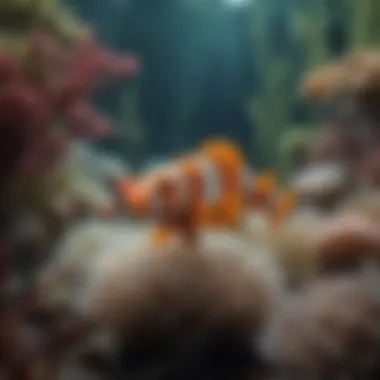
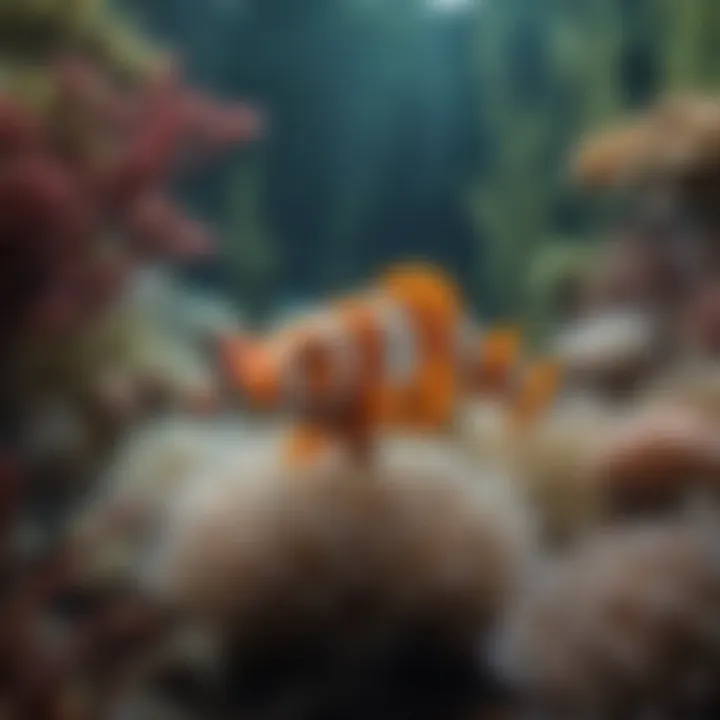
The conservation status of clown fish and sea anemones is critical to understanding the future of their unique relationship. Both species face various threats that not only impact their populations but also the ecosystems they inhabit. Recognizing these challenges and implementing effective conservation strategies is essential for maintaining biodiversity and ecosystem health.
Threats to Clown Fish Populations
Clown fish populations are not immune to the pressures of human activity. Several factors contribute to their declining numbers:
- Habitat destruction: Coral reef degradation, primarily due to climate change, pollution, and overfishing, has significantly reduced suitable habitats for clown fish. The loss of these reefs directly impacts their survival and reproduction.
- Overfishing: In some regions, clown fish are sought after as aquarium pets. Overharvesting can lead to population declines in their natural habitats.
- Climate change: Rising ocean temperatures and acidification can disrupt clown fish development. Warmer waters can lead to increased mortality rates for larvae, affecting future generations.
Threats to Sea Anemones
Sea anemones are equally vulnerable to environmental pressures. Their threats include:
- Ocean acidification: Increased levels of carbon dioxide lead to more acidic oceans, negatively affecting the growth and health of sea anemones.
- Pollution: Nutrient runoff from agricultural and urban areas can cause algal blooms, which may suffocate anemones by blocking sunlight necessary for their survival.
- Climate change: Changes in ocean temperatures can lead to bleaching events, similar to coral bleaching. This affects anemones’ symbiotic relationships, primarily with clown fish, which depend on healthy anemones for shelter.
Conservation Efforts
Efforts to conserve clown fish and sea anemones are increasingly important. Various strategies involve:
- Protected marine areas: Establishing marine protected areas (MPAs) can help safeguard the habitats of both clown fish and anemones from human activities.
- Sustainable aquarium practices: Encouraging responsible breeding and trade practices can reduce pressure on wild populations.
- Public awareness campaigns: Raising awareness about the importance of clown fish-anemone relationships may promote conservation actions.
- Research: Ongoing research into their biological and ecological needs can provide valuable data that informs effective conservation strategies.
Conservation of clown fish and sea anemones is vital to maintaining the health of marine ecosystems, as their interactions play a key role in fostering biodiversity.
By addressing these challenges and implementing strong conservation measures, we can help ensure a sustainable future for both clown fish and sea anemones.
Future of Clown Fish and Anemone Interactions
The future of clown fish and sea anemone interactions holds significant implications for both species and the broader marine ecosystem. As environmental changes accelerate due to climate change and human activity, understanding how these organisms adapt is crucial. The relationship between clown fish and anemones is a distinctive example of co-evolution. This relationship not only enhances the survival of both species but also contributes to a balanced ecosystem. Observing how this symbiotic relationship will evolve under certain stresses is vital for conservation efforts.
Adaptations to Changing Environments
As temperatures rise and ocean acidification progresses, clown fish and anemones may exhibit various adaptations to cope with their changing habitats.
- Physiological Changes: Clown fish might develop more robust mucus layers, which could offer better protection against anemone stings. Additionally, these fish may alter their reproductive strategies to ensure survival during adverse conditions.
- Habitat Selection: Both clown fish and anemones may adjust their habitat preferences. For instance, clown fish could seek out more resilient anemone species that can withstand environmental stress.
- Behavioral Adaptations: The behaviors of clown fish may change in response to new threats or opportunities in their surroundings. This could involve changes in feeding habits or nesting to optimize their chances of survival.
Understanding these adaptations is essential for predicting how the clown fish-anemone symbiosis will endure challenges posed by climate change.
Implications for Ecosystem Health
The interactions between clown fish and anemones have far-reaching implications for ecosystem health. The stability of coral reef environments depends on the various species that inhabit them, including clown fish and their anemone partners.
- Biodiversity Support: The relationship between clown fish and anemones fosters biodiversity. Each organism plays a role that supports others within the coral reef habitat. If these interactions diminish, it may lead to a cascade effect, negatively impacting many marine species.
- Ecosystem Resilience: Healthy clown fish populations support the resilience of coral reefs. Strong mutualistic relationships stabilize the ecosystem, allowing it to better withstand environmental fluctuations.
- Trophic Dynamics: Clown fish also serve as prey for larger predators. Their populations influence the overall food web dynamics. Should their numbers decline, it could affect various trophic levels in the marine environment.
In summary, the future of clown fish and anemone interactions is intertwined with broader ecological processes. Their survival is essential for maintaining marine biodiversity and ecosystem health. Understanding these dynamics will aid in informing conservation strategies to protect these remarkable species.
Finale
Summary of Key Points
- Clown fish have adapted unique behavioral and physiological traits to coexist with sea anemones safely.
- Sea anemones provide clown fish with protection from predators, while clown fish help keep anemones clean and provide nutrients.
- The relationship enhances biodiversity in coral reef ecosystems.
- Threats from environmental changes and human activities highlight the need for targeted conservation efforts.
- Ongoing research will shed light on adaptations that could strengthen their relationship in changing habitats.
In summary, the relationship between clown fish and anemones serves as an essential point of study in marine biology. The insights garnered from this partnership can influence conservation strategies and ecosystem management, ensuring the sustainability of both species.
Calls for Further Research
Continued research is critical to understanding the clown fish-anemone relationship fully. Areas of possible inquiry include:
- Investigating the genetic adaptations in clown fish that allow them to navigate the stinging cells of anemones.
- Studying the impact of climate change on their population dynamics and interactions.
- Assessing the effects of human activities, such as pollution and habitat destruction, on their symbiotic existence.
- Exploring other mutualistic relationships in marine environments that may provide insights applicable to clown fish and anemones.
A call to action is clear: scientists, educators, and conservationists must work collaboratively to protect these iconic marine partners and contribute to the broader understanding of their ecosystems.















